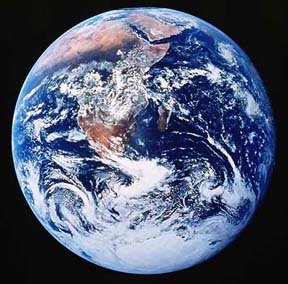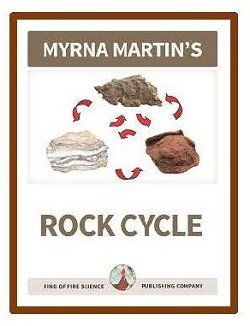What is the Lithosphere?
Rigid outer layer of earth
The lithosphere is the solid and rigid outer layer of our planet. It includes the crust and part of the upper mantle that contains rigid rocks. Beneath this layer is the asthenosphere where the rocks in this part of the upper mantle are not rigid. The rocks can flow like a liquid or break apart similar to silly putty.

Picture of Earth from outer space NASA
Continental and oceanic crust
Two types of crustal plates
This layer of the Earth contains two very different types of crust. The continental crust contains a variety of rocks. They are igneous rocks, sedimentary rocks and metamorphic rocks that make up the rock cycle. Continental crust is lighter than oceanic crust which is made of basalt and gabbro. These rocks are derived from the upper mantle.
Oceanic crust
The oceanic crust is much younger because it is constantly be created at spreading zones and recycled in subduction zones. New oceanic crust forms when crustal plates separate. Molten rock from the upper mantle that has collected in magma chambers oozes onto the ocean floor forming a layer of rocks between the spreading plates. This is the newest and youngest crust on the surface of the Earth.


Click for More Information and to Order
Continental crust
Continental crust
The lithosphere contains the continental crust that is much older than oceanic plates. Continental plates in subduction zones are not recycled because they override the oceanic plates. If continental plates meet that create a collision zone and great mountain chains like the Himalayas rise above the landscape.
Continental plate collides with oceanic plate
When a continental plate and an oceanic plate meet the continental plate overrides the oceanic plate. As the continental plate overrides the oceanic plate it scrapes off the top layers off the oceanic plate.
San Francisco terranes
The layers that are scraped off the oceanic plates are called terranes. Seventeen of these accreted terranes have been identified in the San Francisco bay area and are related to the movement along the San Andreas Fault.
Earthquakes on the plate boundaries
Crustal plate boundaries
Scientists use earthquakes to determine the boundaries of the crustal plates on the surface of the Earth. Earthquakes along fault lines occur frequently as plates move around the Earth.
Major crustal plates
The seven major plates that contain the bulk of the continents and the Pacific Ocean: African Plate, Antarctic Plate, Eurasian Plate, Indo-Australian Plate, North American Plate, South American Plate and the Pacific Plate.
Eight Smaller crustal plates
Smaller Plates
There are also eight smaller plates that are generally shown on maps that display crust plates. These are the smaller but very important plates that have cause great earthquakes in the past.
- Arabian Plate
- Caribbean Plate
- Cocos Plate, Indian Plate
- Juan de Fuca Plate
- Nazca Plate
- Philippine Sea Plate
- Scotia Plate.
Scientists have also identified a number of micro-plates where the land is being torn apart or are subducting.
KIDS FUN Science Bookstore
Check out Myrna Martin's award winning textbooks, e-books, videos and rock sets. The Kids Fun Science Bookstore covers a wide range of earth science topics. Click here to browse.










